Abstract
This study examines mucosa-specific regulatory pathways involved in modulation of interferon-γ (IFN-γ) in lamina propria T cells. Previous studies identified mucosa-specific CD2 cis-elements within the −204 to −108 bp IFNG promoter. Within this region, a single-site nucleotide polymorphism, −179G/T, imparts tumor necrosis factor-α stimulation of IFNG in peripheral blood lymphocytes, and is linked with accelerated AIDS progression. We discovered a putative estrogen response element (ERE) introduced by the −179T, which displays selective activation in peripheral blood mononuclear cells (PBMC) vs lamina propria mononuclear cells (LPMC). Transfection of PBMC with constructs containing the −179G or −179T site revealed CD2-mediated enhancement of the −179T compared to −179G allele, although, in LPMC, a similar level of expression was detected. Electrophoretic mobility shift assay (EMSA) analysis demonstrated CD2-mediated nucleoprotein binding to the −179T but not the −179G in PBMC. In LPMC, binding is constitutive to both −179G and −179T regions. Sequence and EMSA analysis suggests that the −179T allele creates an ERE-like binding site capable of binding recombinant estrogen receptor. Estrogen response element transactivation is enhanced by CD2 signaling, but inhibited by estrogen in PBMC but not in LPMC, although expression of estrogen receptor was similar. This is the first report to describe a potential molecular mechanism responsible for selectively controlling IFN-γ production in LPMC.
This is a preview of subscription content, access via your institution
Access options
Subscribe to this journal
Receive 6 digital issues and online access to articles
$119.00 per year
only $19.83 per issue
Buy this article
- Purchase on Springer Link
- Instant access to full article PDF
Prices may be subject to local taxes which are calculated during checkout







Similar content being viewed by others
References
Young HA, Hardy KJ . Role of interferon-gamma in immune cell regulation. J Leukoc Biol 1995; 58: 373–381.
Lewis DB, Wilson CB . Gamma-interferon: an immunoregulatory lymphokine with immunotherapeutic potential. Pediatr Infect Dis J 1990; 9: 642–651.
Sehgal PB, May LT, Landsberger FR . Primary structural repeats in human and in murine gamma-interferon. J Interferon Res 1986; 6: 39–42.
Zhou W, Chang S, Aune TM . Long-range histone acetylation of the Ifng gene is an essential feature of T cell differentiation. Proc Natl Acad Sci USA 2004; 101: 2440–2445.
Eivazova ER, Aune TM . Dynamic alterations in the conformation of the Ifng gene region during T helper cell differentiation. Proc Natl Acad Sci USA 2004; 101: 251–256.
Powrie F . T cells in inflammatory bowel disease: protective and pathogenic roles. Immunity 1995; 3: 171–174.
Strober W, Kelsall B, Fuss I, Marth T, Ludviksson B, Ehrhardt R et al. Reciprocal IFN-gamma and TGF-beta responses regulate the occurrence of mucosal inflammation. Immunol Today 1997; 18: 61–64.
Sartor RB . Cytokines in intestinal inflammation: pathophysiological and clinical considerations. Gastroenterology 1994; 106: 533–539.
Monteleone G, MacDonald TT, Wathen NC, Pallone F, Pender SL . Enhancing lamina propria Th1 cell responses with interleukin 12 produces severe tissue injury. Gastroenterology 1999; 117: 1069–1077.
Pirzer UC, Schurmann G, Post S, Betzler M, Meuer SC . Differential responsiveness to CD3-Ti vs. CD2-dependent activation of human intestinal T lymphocytes. Eur J Immunol 1990; 20: 2339–2342.
Targan SR, Deem RL, Liu M, Wang S, Nel A . Definition of a lamina propria T cell responsive state. Enhanced cytokine responsiveness of T cells stimulated through the CD2 pathway. J Immunol 1995; 154: 664–675.
Boirivant M, Fuss I, Fiocchi C, Klein JS, Strong SA, Strober W . Hypoproliferative human lamina propria T cells retain the capacity to secrete lymphokines when stimulated via CD2/CD28 pathways. Proc Assoc Am Physicians 1996; 108: 55–67.
Gonsky R, Deem RL, Hughes CC, Targan SR . Activation of the CD2 pathway in lamina propria T cells up-regulates functionally active AP-1 binding to the IL-2 promoter, resulting in messenger RNA transcription and IL-2 secretion. J Immunol 1998; 160: 4914–4922.
Gonsky R, Deem RL, Bream JH, Lee DH, Young HA, Targan SR . Mucosa-specific targets for regulation of IFN-gamma expression: lamina propria T cells use different cis-elements than peripheral blood T cells to regulate transactivation of IFN-gamma expression. J Immunol 2000; 164: 1399–1407.
Gonsky R, Deem RL, Young HA, Targan SR . CD2 mediates activation of the IFN-gamma intronic STAT binding region in mucosal T cells. Eur J Immunol 2003; 33: 1152–1162.
Penix LA, Sweetser MT, Weaver WM, Hoeffler JP, Kerppola TK, Wilson CB . The proximal regulatory element of the interferon-gamma promoter mediates selective expression in T cells. J Biol Chem 1996; 271: 31964–31972.
Bream JH, Ping A, Zhang X, Winkler C, Young HA . A single nucleotide polymorphism in the proximal IFN-gamma promoter alters control of gene transcription. Genes Immun 2002; 3: 165–169.
An P, Vlahov D, Margolick JB, Phair J, O'Brien TR, Lautenberger J et al. A tumor necrosis factor-alpha-inducible promoter variant of interferon-gamma accelerates CD4+ T cell depletion in human immunodeficiency virus-1-infected individuals. J Infect Dis 2003; 188: 228–231.
Shanahan F, Brogan M, Targan S . Human mucosal cytotoxic effector cells. Gastroenterology 1987; 92: 1951–1957.
Cippitelli M, Santoni A . Vitamin D3: a transcriptional modulator of the interferon-gamma gene. Eur J Immunol 1998; 28: 3017–3030.
Cippitelli M, Ye J, Viggiano V, Sica A, Ghosh P, Gulino A et al. Retinoic acid-induced transcriptional modulation of the human interferon-gamma promoter. J Biol Chem 1996; 271: 26783–26793.
Gonsky R, Deem RL, Lee DH, Chen A, Targan SR . CD28 costimulation augments IL-2 secretion of activated lamina propria T cells by increasing mRNA stability without enhancing IL-2 gene transactivation. J Immunol 1999; 162: 6621–6629.
Aune TM, Penix LA, Rincon MR, Flavell RA . Differential transcription directed by discrete gamma interferon promoter elements in naive and memory (effector) CD4T cells and CD8T cells. Mol Cell Biol 1997; 17: 199–208.
Melvin AJ, McGurn ME, Bort SJ, Gibson C, Lewis DB . Hypomethylation of the interferon-gamma gene correlates with its expression by primary T-lineage cells. Eur J Immunol 1995; 25: 426–430.
White GP, Watt PM, Holt BJ, Holt PG . Differential patterns of methylation of the IFN-gamma promoter at CpG and non-CpG sites underlie differences in IFN-gamma gene expression between human neonatal and adult CD45RO− T cells. J Immunol 2002; 168: 2820–2827.
Yano S, Ghosh P, Kusaba H, Buchholz M, Longo DL . Effect of promoter methylation on the regulation of IFN-gamma gene during in vitro differentiation of human peripheral blood T cells into a Th2 population. J Immunol 2003; 171: 2510–2516.
Mikovits JA, Young HA, Vertino P, Issa JP, Pitha PM, Turcoski-Corrales S et al. Infection with human immunodeficiency virus type 1 upregulates DNA methyltransferase, resulting in de novo methylation of the gamma interferon (IFN-gamma) promoter and subsequent downregulation of IFN-gamma production. Mol Cell Biol 1998; 18: 5166–5177.
Straus WL, Eisen GM, Sandler RS, Murray SC, Sessions JT . Crohn's disease: does race matter? The mid-atlantic crohn's disease study group. Am J Gastroenterol 2000; 95: 479–483.
Reddy SI, Burakoff R . Inflammatory bowel disease in African Americans. Inflamm Bowel Dis 2003; 9: 380–385.
Vandenbroeck K, Goris A . Cytokine gene polymorphisms in multifactorial diseases: gateways to novel targets for immunotherapy? Trends Pharmacol Sci 2003; 24: 284–289.
Cippitelli M, Sica A, Viggiano V, Ye J, Ghosh P, Birrer MJ et al. Negative transcriptional regulation of the interferon-gamma promoter by glucocorticoids and dominant negative mutants of c-Jun. J Biol Chem 1995; 270: 12548–12556.
Klein-Hitpass L, Schorpp M, Wagner U, Ryffel GU . An estrogen-responsive element derived from the 5′ flanking region of the Xenopus vitellogenin A2 gene functions in transfected human cells. Cell 1986; 46: 1053–1061.
Curtis SW, Korach KS . Uterine estrogen receptor–DNA complexes: effects of different ERE sequences, ligands, and receptor forms. Mol Endocrinol 1991; 5: 959–966.
Klinge CM, Peale Jr FV, Hilf R, Bambara RA, Zain S . Cooperative estrogen receptor interaction with consensus or variant estrogen responsive elements in vitro. Cancer Res 1992; 52: 1073–1081.
Driscoll MD, Sathya G, Muyan M, Klinge CM, Hilf R, Bambara RA . Sequence requirements for estrogen receptor binding to estrogen response elements. J Biol Chem 1998; 273: 29321–29330.
Hall JM, McDonnell DP, Korach KS . Allosteric regulation of estrogen receptor structure, function, and coactivator recruitment by different estrogen response elements. Mol Endocrinol 2002; 16: 469–486.
Qin H, Sun Y, Benveniste EN . The transcription factors Sp1, Sp3, and AP-2 are required for constitutive matrix metalloproteinase-2 gene expression in astroglioma cells. J Biol Chem 1999; 274: 29130–29137.
Verdu EF, Deng Y, Bercik P, Collins SM . Modulatory effects of estrogen in two murine models of experimental colitis. Am J Physiol Gastrointest Liver Physiol 2002; 283: G27–G36.
Harris HA, Albert LM, Leathurby Y, Malamas MS, Mewshaw RE, Miller CP et al. Evaluation of an estrogen receptor-beta agonist in animal models of human disease. Endocrinology 2003; 144: 4241–4249.
Harnish DC, Albert LM, Leathurby Y, Eckert AM, Ciarletta A, Kasaian M et al. Beneficial effects of estrogen treatment in the HLA-B27 transgenic rat model of inflammatory bowel disease. Am J Physiol Gastrointest Liver Physiol 2004; 286: G118–G125.
Acknowledgements
We thank Grace Kim and Jacyln Zhou for providing cultured LPMC. This work was supported by United States Public Health Service Grants DK-43211 and DK-46763 and Cedars-Sinai Medical Center Inflammatory Bowel Disease Research Funds.
Author information
Authors and Affiliations
Corresponding author
Rights and permissions
About this article
Cite this article
Gonsky, R., Deem, R., Bream, J. et al. An IFNG SNP with an estrogen-like response element selectively enhances promoter expression in peripheral but not lamina propria T cells. Genes Immun 7, 342–351 (2006). https://doi.org/10.1038/sj.gene.6364305
Received:
Revised:
Accepted:
Published:
Issue Date:
DOI: https://doi.org/10.1038/sj.gene.6364305



